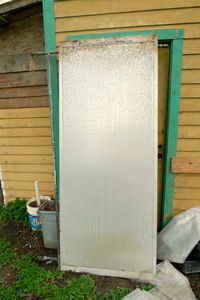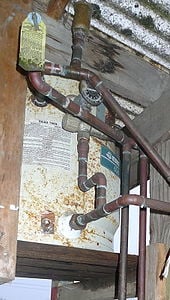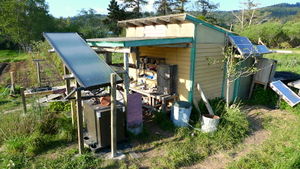
This project was replaced by Bayside Park Farm solar hot water.
Background[edit | edit source]
The Arcata Educational Farm is a CSA (Community-Supported Agriculture establishment) that provides local organic produce for members/shareholders and hands-on agricultural education for local students and residents. Adjacent and connected to the farm is the upcoming Bayside Community Garden, a place for residents to grow their own produce and learn how to farm organically and sustainably.
As part of our ENGR305 class, our team was asked to fix the Solar water heater system there (the previous one developed a leak from the winter freeze and subsequent cracking). We improved the system by upgrading, winterproofing it, enlarging the water tank, and integrating its output into a vegetable-washing system.
Opportunity Definition[edit | edit source]
-
The farm's previous solar collector was damaged by a winter freeze
-
The previous water tank was too small to meet the farm's needs
- Who
- ENGR305 Spring 2010 students Melissa Pawson, Kristy Lindquist and Roger Tuan are serving the Arcata Educational Farm.
- What
- Retrofit, repair, and improve the solar hot water system at the farm.
- Why
- We were asked to fix the solar hot water system so the farm will once again have access to hot water. This could be useful for future community events held throughout the year, regular use for washing dishes, as well as personal cleansing!
- When
- Our project took approximately 15 weeks in duration, starting February 2010 and ending May 15, 2010.
- Where
- The Arcata Educational Farm is located at 930 Old Arcata Road in the Sunnybrae neighborhood of Arcata, CA, USA.
Criteria[edit | edit source]
In the design phase of our project, we consulted the farm about their specific requirements. We broke the requirements down into a sets of quantifiable criteria and other considerations.
| Criteria, Constraints, and Weights for the AEF Solar Water Heater Project | ||
|---|---|---|
| Criteria | Constraint | Weight |
| Water temperature | Warm enough to bathe and wash vegetables with; not too hot to scald people, including kids | 10 |
| Hot water duration /
Total heat capacity |
At least 30 minutes of continual usage | 10 |
| Washing station
efficiency |
Must be more efficient than the current kitchen sink | 5 |
| Cost | Must cost less than $50 out-of-pocket, not including value of donated materials. | 5 |
| Simplicity /
documentation |
Must be understandable by farm staff with no prior Solar Water Heater experience. | 10 |
Considerations[edit | edit source]
- Aesthetics
- Color
- Should blend in with existing buildings as much as possible and not be too much of an eyesore
- Materials
- Weather proof?
- Easily acquirable?
- Physical size
- Must not obstruct paths or present a hazard to visitors
- Vegetable station must be large enough to wash vegetables with
- Drainage -- Must be compatible with existing graywater system
Budget[edit | edit source]
Actual Costs[edit | edit source]
| Item | Source | Value ($) | Actual Cost ($) |
|---|---|---|---|
| Vegetable washing tub | Garage sale | $20 | $1 |
| Water tank | Donation from Six Rivers Solar | $4000 | $0 |
| Solar pump controller | Donation from Six Rivers Solar | $200 | $0 |
| DC Pump | Donation from Six Rivers Solar | $200 | $0 |
| Plastic pallet | Donation from Murphy's Market Sunnybrae | $88 | $0 |
| Hardware supplies | Donation from Sunnybrae Ace Hardware | $20 | $0 |
| 1.5" PVC Pipe | Donation from Arcata Community Recycling Center | $10 | $0 |
| Ice Maker Flex Tubing and Connectors | Bought from West Coast Plumbing | $24.71 | $24.71 |
| PVC Fittings | Bought from Arcata Lumber | $3.24 | $3.24 |
| Vegetable Washing Station Hardware | Bought from Sunnybrae Ace Hardware | $44.64 | $44.64 |
| Photovoltaic Hardware | Bought from Hensel's Ace Hardware | $34.60 | $34.60 |
| Photovoltaic Hardware | Bought from Sunnybrae Ace Hardware | $5.71 | $5.71 |
| Photovoltaic Hardware | Bought from Hensel's Ace Hardware | $19.41 | $19.41 |
| Photovoltaic Hardware | Bought from Sunnybrae Ace Hardware | $1.09 | $1.09 |
| Collector Frame Hardware | Bought from Sunnybrae Ace Hardware | $11.74 | $11.74 |
| Total Actual Cost | $146.14 | ||
Expected Costs[edit | edit source]
| Quantity | Material / Service | Source | Cost ($) | Total ($) |
|---|---|---|---|---|
| 20 | Copper piping (in feet) | Hardware store | $1.00 | $20.00 |
| 1 | Labor (trench digging, welding, etc.) | City of Arcata | $0.00 | $0.00 |
| 30 | Metal parts for vegetable washer (price per pound) | Arcata Scrap and Salvage | $1.00 | $30.00 |
| 1 | Solar Collector | CCAT | $0.00 | $0.00 |
| 1 | Explanatory Sign | Friend of Maddy's | $0.00 | $0.00 |
| 30 | Scrap wood for various uses (in pounds) | Arcata Ed Farm | $0.00 | $0.00 |
| 1 | Primer for wood to prevent rotting | Hardware store | $20.00 | $20.00 |
| 3 | Screws, nails, etc. (bags of) | Arcata Recycling Center Thrift Store | $2.00 | $6.00 |
| 1 | Showerhead / vegetable washer aerator | Arcata Recycling Center Thrift Store | $15.00 | $15.00 |
| 1 | Shower curtain | Arcata Ed Farm | $0.00 | $0.00 |
| 1 | Gravel | Arcata Ed Farm | $0.00 | $0.00 |
| 1 | PVC piping to greywater system | City of Arcata | $0.00 | $0.00 |
| 1 | Water barrier for drain | Scrapyard | $5.00 | $5.00 |
| 1 | Floormat / platform for shower bottom | Scrapyard, thrift store, or hardware store | $15.00 | $15.00 |
| Total Cost | $111.00 | |||
Timeline[edit | edit source]
This project was done in the spring of 2010
| By… | We did… |
|---|---|
| 3/10 | Remove existing installation. |
| 3/12 | Check out Deep-Seeded Farm's veggie washer. |
| 3/15 & 3/16 | Designed original vegetable washing Station. |
| 3/25 & 3/26 | Built collector frame |
| 4/07 | Make Amendments to vegetable washing station |
| 4/10 | Aided Six Rivers Solar in installing the solar hot water heating system. |
| 4/30 & 4/31 | Constructed Vegetable washing station and PVC piping to grey water system. |
| 5/01 | Testing and data collection (temperature measurements, etc.) |
| 5/03 | Analyze additional data collected by farm staff, re-evaluate system performance |
| 5/03 | Construction on photovoltaic addition |
| 5/03 | Finished Construction on photovoltaic addition. Testing. |
| 5/05 | Completion of Solar Hot Water Heater, Vegetable Washing Station and Photovoltaic Addition |
| 5/07 | Mathematically estimate year-round performance |
| 5/09 | Update appropedia web page. |
| 5/09 | Design Signage |
| 5/10 | Finished AEF Solar Hot Water Heating Appropedia Website |
What We Did: Our report for the finished project[edit | edit source]
There were three main parts to our project in efforts to provide hot water to the Arcata Educational Farm. We captured the power of the sun to heat, distribute, and enjoy hot water! It is definitely true that these projects tend to get bigger once they are started. There were many different parts and pieces that were tied into the three stages of our project that none of us could have predicted. Everything about our solar hot water heating system at the Arcata Educational Farm got bigger and better.
Overview[edit | edit source]
Solar Water Heater and Collector Frame[edit | edit source]
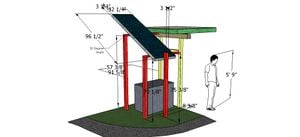
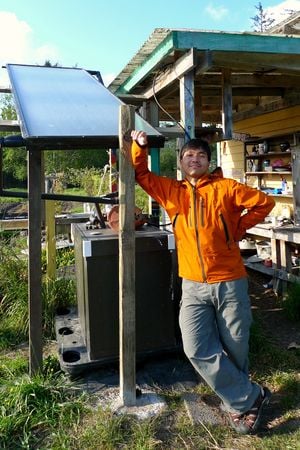
We decided to reconstruct a new solar hot water heating system after a generous donation from Six Rivers Solar. This began a huge project in coordination with Six Rivers Solar to make sure their donation was installed within our project timeline. This donation also forced us to think about space efficiency; this system could not be in the way of daily activities of the farmers. Roger Tuan designed a stand so that the collector could be positioned above the tank. We built the collector frame from scrap wood that was on site at the farm. This frame raised the collector to capture the optimal amount of solar insolation at approximately 30 degrees. We positioned the water storage tank directly under the solar collector for maximum space efficiency.
How it works:
A pump was installed to bring cooler water from the tank to the collector. Thermal convection and gravity refills the tank with hot water. A controller system connected to the system automatically regulates the pumping unit. A set temperature differential of 12 degrees Fahrenheit between the collector and tank triggers the pump to turn off and on. After the water is heated, it is just about ready to use. A mixing chamber blends the cold and hot water before the it flows to the faucet. This ensures the hot water won't burn anyone. The water temperature can easily reach over 100 degrees Fahrenheit.
Additional Photovoltaic Panel and Frame Construction[edit | edit source]
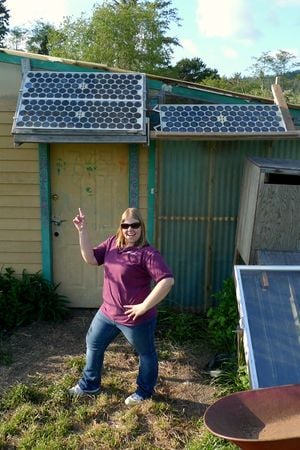
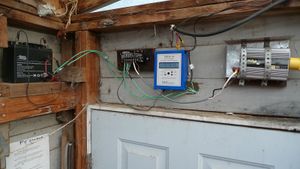
We used the energy of the sun and captured its potential with photovoltaic (PV) panels. The Arcata Educational Farm had an extra PV panel that was not being utilized. The farm had preexisting solar panels used to power their answering machine and radio, but the new pump placed an additional load that the system could not handle. Kristy Lindquist designed an additional frame so that we could install an additional PV panel. We built a second frame from the scrap wood to raise the panel and position it at a 45 degree angle, like the others. We connected our panel in parallel to two preexisting ones in order to maintain voltage. We also enclosed all the wiring, even the wiring we didn't do, so that this array was safer. Together, the new system puts out approximately 19 volts at 8.6 amps, or 163.4 watts. The power charges a battery and the stored energy will ensure a constant power supply to the controller that regulates the pumping unit.
Vegetable Washing Station[edit | edit source]
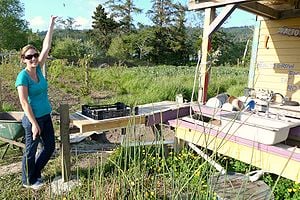
The solar water heater allows the farmers to control the temperature at which they are washing the vegetables. Some thicker skinned vegetables can be washed with warmer water. See informational sections below on washing methods. Melissa Pawson designed the vegetable washing station. We built a vegetable washing station from scrap wood that was compatible with the farm's current vegetable crates and extended an existing table. We first set a post in concrete; we believed it to be level however once we started to build the rest of the station we discovered that it wasn't. We solved this problem by using a shim to stabilize the rest of the frame. We retrofitted a plastic container, purchased for $1 at a garage sale, and attached a drain. We used PVC piping, donated from the Arcata Recycling's Thrift Store, two 90 degree fittings and one 45 degree fitting to construct a draining system so that the water used at the vegetable washing station can drain into the existing greywater system.
Testing[edit | edit source]
Solar Water Heating System[edit | edit source]
The solar hot water heating system was fully installed by 6 Rivers Solar, with assistance from our group on April 30th, 2010. It took a week from its installation date to reach approximately 120 degrees Fahrenheit. We used the controller installed with the solar hot water heating system to measure the temperature. We also used a physical test to make sure our results matched the results that the controller was giving. We used the touch test for all temperature reading we took from the controller. Our physical tests reinforced our temperatures given by the controller.
| Date | Temperature Readings in degrees |
|---|---|
| 05/02 | 53 |
| 05/03 | 63 |
| 05/06 | 88 |
| 05/07 | 116 |
The collector frame was tested once the solar collector was placed on top of it. The collector frame withstood the weight of the collector, which was a positive result. Once the solar hot water system was fully functional the collector frame was tested again to make sure that it could hold the weight of the collector plus the water that was being heated within it. Once again the collector frame had positive results. For greater stability, we supported the collector with L brackets. Based on our calculations, an average of $4.71 is saved every time the 150 gallon tank is refilled. This is based on an electricity rate of $.12KWh. Assuming the collector refills once a day to reheat the water from the previous night's drop in temperature, aprroximately $45 per month is saved. [1]
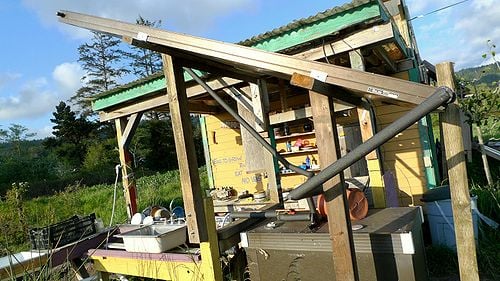
Additional Photovoltaic Panel[edit | edit source]
Our first attempt at testing the PV panel with a multimeter gave us inconclusive results. We could not get a voltage or amperage reading. Our scientific guess is that we were not making a proper connection with the PV panel using the multimeter. Needless to say, we were less than satisfied with our results. Roger Tuan used his connections with the engineering department to have assistance in testing the photovoltaic panel again. This time the results were more like what we had expected. Marty Reed assisted us in getting a voltage reading of about 19 V. This also helped us properly diagnose the problem from the first testing. Our final testing of the PV panel was before we wired it in parallel to the the existing panels. Again we did not get proper results using our multimeter. On May 5th, Lonny Grafman assisted us with our testing. At first, Lonny was receiving the same results. After he disconnected the wires from the panels he saw that there was a little corrosion present. Then Roger Tuan and Melissa Pawson scraped off the corroded areas. After this was done our group connected all three panels together. Once everything was connected we tested our PV array and measured 19 V and 8.6 amps (163.4 watts). We also checked that the solar hot water system's controller and the farm's telephone were operational.
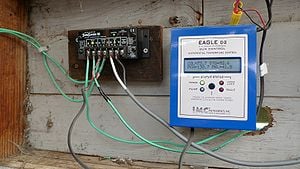
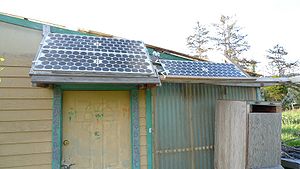
Vegetable Washing Station[edit | edit source]
Our primary test was to make sure that the frame we built for the vegetable washing sink was compatible. The dimensions of the sink were 28 inches long, 15.75 inches wide and 5.75 inches deep. We received positive results. We also tested to make sure the washing crates that the farm used fit inside the vegetable washing sink. Our results were positive.
Our second testing phase was to test to see how much water it could hold. The vegetable washing station stink has a volume approximately 11 gallons. The frame was able to hold this volume full of water, a weight of approximately 90 pounds.
Our third testing phase was to make sure that our PVC piping drainage used worked successfully and properly drained into the grey water system. We drained the volume of the sink successfully out through the PVC pipe into the grey water system. We also considered the angles of the drainage system. We used 90 degree fittings to connect the piping because it was our only option, however we tried to mitigate clogging issues by sloping the piping downward so gravity could assist in the drainage.
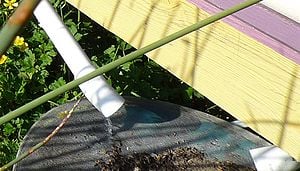
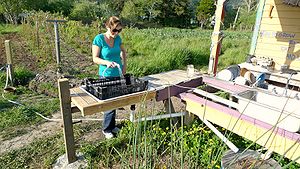
Calculations[edit | edit source]
After running our tests we performed several energy savings calculations. We took the volume of the collector and tank as well as the density of water to calculate the mass of water contained in each unit. From there we multiplied the mass of water (g), specific heat of water (4.186 J/g*C), and targeted change in temperature(65.5 C)to calculate the energy required to heat each unit. Approximately 12.6 KWh is required to heat collector and 39.6 KWh is required to heat the tank. Finally, we used PG&E's electricity rate of $.12 KWh multiplied by each requirement to derive the final savings in dollar with each unit. Approximately $1.50 is saved for each refill of the collector and $4.71 is saved for each refill of the tank. We also calculated an approximate savings per month assuming the the collector refills once a day to reheat the water cooled over night. We took 30 days and multiplied by the $1.50 per collector refill that results in a total savings of $45 each month! This is an estimate based on a targeted temperature fluctuation and is subject to change during different times of the year. The follow link provides insight to our calculations! [2]
Photovoltaic Array
For our project, we had to install another PV panel to make sure the farm was receiving the power that it was used to and also to run a pump on the solar hot water heater. The array was wired in parallel, which increases the power output. In a parallel circuit voltage (V) stays the same and the current (I) adds together.
| Series Circuit | Parallel Circuit |
|---|---|
| Current stays the same | Current adds together |
| It = I1 = I2 =... | It = I1 + I2 + I3 +... |
| Voltage adds together | Voltage stays the same |
| Vt = V1 + V2 + V3 +... | Vt = V1 = V2 = V3... |
From this table we can see that the voltage will stay the same in our array and the current will add together.
This table gives the theoretical amps and volts of the panel we installed into our array. These values were given by Lonny Grafman for Appropriate Technology Engineering 305, a course at Cal Poly Humboldt.
| Theoretical | Panel Value |
|---|---|
| Radius of a single cell (square inches) | 1.5 |
| Number of Cells in Series | 36 |
| Number of Parallel Legs | 2 |
| Area of one cell (square inches)(pi*r2) | 7.07 |
| Amps/in2 | 0.22/in2 |
| Amps per Leg (Amps) | 1.56 |
| Total Amps from Panel | 3.12 |
| Volts/cell | .45V/cell |
| Total Volts from Panel | 16.2 |
| Power generation by Panel P=IV (in Watts) | 50.45 |
Observed Values
Our observed values were found using a multimeter that measures voltage and amperage. We tested the panel right before we installed it and it gave us a reading of 19 volts and 2.86 amps. Power = voltage * current, so Power = 19V*2.86A = 54.46 Watts.
After we installed the whole array in parallel. The multimeter measured 8.6 amps and 19 volts. We can find the power output of the array by using the equation above. Power = 19V*8.6A = 163.4 Watts.
We can check if this makes sense by using the power equation from the top table. P = Vt * (I1 + I2 +I3). P = 19 volts * (2.86 + 2.86 + 2.86) = 163 Watts.
Infrastructure[edit | edit source]
Maintenance
From the PV array to the hot water heating system to the vegetable washing station there are many things we should evaluate in one year from the final completion date. With the addition of the PV panel we can check to make sure all of the connections are still connected correctly. We can evaluate if the controller and telephone are still operational. We should also make sure that the pump regulator is still functioning at the proper set points.
We can evaluate if the collector frame is still working by making sure the collector is in the same place. We can also check to make sure that the frame does not appear warped and that none of the wood is cracked. We can make sure the hot water heating system is still operational by evaluating the temperature given by the controller and also use a physical touch test to confirm the temperature.
We can evaluate that the vegetable washing station is still functional by observing the status of the constructed frame and sink. If nothing appears to be broken or cracked it would seem that the vegetable station is still functional and can be used. We will also make sure that the PVC pipe is draining correctly into the greywater system. We will run water from the spray nozzle through the vegetable washing station's piping to make sure there are not any clogs. The farm can prevent clogs from catching organic mater with the drain we installed and also allowing water to run through the system periodically.
Literature Review[edit | edit source]
Solar Hot Water Heater[edit | edit source]
A Flat Plate Collector[edit | edit source]
Flat plate collectors are the most commonly used collector in the world for domestic solar water heating. They are durable and effective and have an operating range of zero degrees Fahrenheit - 180 degrees Fahrenheit.[1]
Installing, Plumbing and Wiring Your Collectors[edit | edit source]
Solar installation is carpentry, plumbing and electrical work all mixed together.
- Piping and Pipe Insulation
- Copper tubing is the best kind of pipe to use for the solar loop because it can withstand a temperature range from 300 degrees Fahrenheit to -30 Fahrenheit, it is durable and easy to install.[2]
- Testing the System
- To check for leaks you can use air pressure or water pressure.[2]
Types of Flat Plate Collector Systems[edit | edit source]
- Thermosiphon System
- This system is the simplest of all open loop, flat plate systems. There is no need for pumps or electrical controls. Water heated in the collector becomes less dense and rises into the storage tank, while cooler, denser water falls from the tank and enters the collector, all in a continuous cycle that lasts as long as the sun delivers enough energy. With no electrical controls and no antifreeze fluid, a collector in this system has no build-in freeze protection except for the protection of installing it behind glazing within the thermal envelope of the building where it isn't supposed to freeze.;[1]Drain Back System
- This unpressurized closed loop system is designed to automatically drain itself whenever the pump is off without using electrical operated valves or other special components. When the differential thermostat senses that solar heat is available, the pump is switched on to draw "collector" water from an unpressurized tank and run it through the collector. When the pump stops, gravity takes over; water in the collector and the connection pipes simply drains back into the tank, A heat exchanger carrying pressurized domestic water is immersed in the upper party of the tank. When hot water is used, the water is preheated in the exchanger before it flows into the back-up water heater and out to points of use.;[1]Recirculation and Drain-Down Systems
- This system is made up of two flat plate systems that are protected with electrical and mechanical controls. The recirculation system works by taking a little hot water from the solar storage and pumping it through the collector array. It's good for climates that only occasionally experience just-below-freezing temperatures. The drain-down system, not to be confused with drain-back, uses a special valve that closes off the pressurized lines to the collectors and allows them to drain away that one or two gallons they and the pipelines carry. Both are pressurized open loop systems that circulate potable water between the collectors and the storage tank.;[1]Fluid Freeze Protection System
- This systems is closely related to the flat plate collector loop, except that antifreeze fluid replaces the water. It is a closed loop system and a heat exchanger is required. The right antifreeze fluid is important because some are poisonous, some eat away at the copper piping and all fluids don't transfer heat as well as water.:[1]*Example: The Bread Box Design: A Passive Solar Water Heater
- This system is made up of a two-tank batch-type system that provides approximately 60 percent of the annual hot water needs of a family of three at a total cost of $400. It works by sending pressurized domestic water through the tanks. The "collector" tanks preheat the water before entering the back-up water heater.[1]
Vegetable Washing Station[edit | edit source]
Different Ways to Wash Vegetables[edit | edit source]
Vegetables and fruits are often covered with pesticides, herbicides, fungicides or wax. To maintain freshness it is best to wash produce before use and not before storage, which can make it spoil faster.
- Firm-skinned Produce
- To wash firm-skimmed produce you should use a little warm water and a scrub brush if needed. It is also important to rinse produce well to remove any residual dirt.[3]
- Soft-skinned Produce
- To wash soft-skinned produce soak vegetables or fruit for a minutes. The temperature should be between room temperature or a couple degrees cooler.;[3]Common Disinfectants
- This study was undertaken to determine the efficacy of three commonly used disinfectants in packing-houses of Culiacan, Mexico:
- Water samples were taken after 2 minutes of contact with chlorine-based products and tested for the particular microorganisms. TST and NaOCl were found to effectively reduce for bacterial pathogens and viral indicators. The highest inactivation rate was observed when the turbidity was low and the disinfectant was applied at 300 mg. TCM did not show effective results when compared with the TST and NaOCl. These findings suggest that turbidity created by the organic and inorganic material present in the water tanks carried by the fresh produce may affect the efficacy of the chlorine-based products.[4]
Example of a Washing and Processing Station[edit | edit source]
Colorado State University has assembled an Information Guide for Community Supported Agriculture Growers. Along with the plethora of useful information they include how they built a produce washing and processing station. They used a hoop house structure with shade cloth over it to provide a cooler environment for cleaning, boxing, and bunching. The station was made using recycled materials. The sinks were bought at the local Habitat for Humanity thrift store and a table was constructed for them using an old metal table frame and scrap wood from a local door manufacturing company. Wooden floors were also made using this same scrap wood and lashed together with twine or nailed into a base to provide a non-muddy area to walk on. Municipal water was used to wash the vegetables with a hose.
They also explain the different ways they washed the vegetables that they grew at the farm.
- For root crops: They soaked them in buckets or sinks of water, then they held them by the tops and hosed them off with a high pressure spigot. The roots were then bunched and boxed.
- For leaf crops: They dunked entire waxed boxes of lettuce, chard, or spinach in cool water in a large sink. Then they let the boxes drain thoroughly and covered exposed areas with freezer or packing paper to prevent desiccation. This method does tend to deteriorate boxes if they are re-used often; to counteract this problem they began using re-usable plastic field totes instead of cardboard boxes. After processing, the produce was either immediately brought to campus for the CSA pick-up or stored temporarily in a cooler.[5]
References[edit | edit source]
Footnotes for cited materials[edit | edit source]
- ↑ 1.0 1.1 1.2 1.3 1.4 1.5 fckLRCarter, Joe (1981). "Solarizing Your Present Home." Practical Solar Heating Systems You Can Build,Rodale Press, Inc.,USA, Chapter 2 Domestic Water Heating.
- ↑ 2.0 2.1 Ramlow, Bob (2006. "Solar Water Heating." A Comprehensive Guide to Solar Water and Space Heating Systems, New Society Publishers, Gabriola Island, Canada, Chapter 5 Solar Water Heating Systems.
- ↑ 3.0 3.1 Hunter, Mason (2005. "Green Clean." The Environmentally Sound Guide to Cleaning Your Home, Melcher Media, New York, NY, Chapter 3 The Kitchen, 44-65.
- ↑ Chaidez, Cristobal, Moreno, Maria, Rubio, Werner, Angulo, Miguel, Valdez, Benigno (2003). "Comparison of the disinfection efficacy of chlorine-based products for inactivation of viral indicators and pathogenic bacteria in produce wash water." International Journal of Environmental Health Research, Vol. 13, Issue 3, p295-303.
- ↑ Colorado State University (2006). "CSU CSA (Community Supported Agriculture)Information for Growers." <http://www.specialtycrops.colostate.edu/CSU_CSA/SCP_csu_csa_growers.htm#top> (Feb. 10 2010)
Additional materials referenced but not cited[edit | edit source]
Books[edit | edit source]
- Keisling, Bill. (1983). "The homeowner's handbook of solar water heating systems." Rodale Press, Emmaus, Pa.
- McConnell, Charles. (1977). "Plumbers and Pipe Fitters Library." Water Supply, Drainage, Calculations. Howard W. Sams & Co., Inc. Indianapolis, Indiana.
- Kut, David. Hare, Gerard. (1979). "Applied Solar Energy." A guide to the design, installation and maintenance of heating and hot water services. The Architectural Press. London, England.
- Bainbridge, D. A. The integral passive solar water heater book. Passive Solar Institute, PO Box 722.
- Basic design and operation, different types, solar availability across the USA
- Chiras, Daniel D. 2006. The homeowner's guide to renewable energy. New Society Publishers, April 3. Gunerhan, Huseyin, and Arif Hepbasli. 2007.
- Methods to deal with freezing
- Schroeder, Daniel V. 2000. An Introduction to Thermal Physics. San Francisco, CA: Addison Wesley.
- To better understand math and physics involved in our project
Peer-reviewed Articles[edit | edit source]
- Annous, B. A., G. M. Sapers, A. M. Mattrazzo, and D. C. R. Riordan. 2001. Efficacy of washing with a commercial flatbed brush washer, using conventional and experimental washing agents, in reducing populations of Escherichia coli on artificially inoculated apples. Journal of Food Protection&# 174; 64, no. 2: 159-163.
- For vegetable washing information -- is a commercial agent necessary vs plain water?
- Exergetic modeling and performance evaluation of solar water heating systems for building applications. Energy and Buildings 39, no. 5 (May): 509-516. doi:10.1016/j.enbuild.2006.09.003. http://www.sciencedirect.com/science/article/B6V2V-4M5WHXR-4/2/4d54fed9fe0e7c8e8f6ba6ad58337d1a.
- Mathematical modeling of exergy
Websites[edit | edit source]
- National Renewable Energy Laboratory. Natural Renewable Energy Laboratory: Dynamic Maps, GIS Data, and Analysis Tools - Solar Maps. http://www.nrel.gov/gis/solar.html.
- Solar availability maps
- Guidance for Industry: Guide to Minimize Microbial Food Safety Hazards for Fresh Fruits and Vegetables. WebContent. http://web.archive.org/web/20130307162814/http://www.fda.gov/Food/GuidanceComplianceRegulatoryInformation/GuidanceDocuments/ProduceandPlanProducts/ucm064574.htm.
- FDA produce safety guidelines for fruits and veggies
- Center for Food Safety and Applied Nutrition. Produce and Plant Products. WebContent. http://web.archive.org/web/20130307162430/http://www.fda.gov/Food/GuidanceComplianceRegulatoryInformation/GuidanceDocuments/ProduceandPlanProducts/default.htm.
- As above, but for certain specific veggies
- US Department of Energy. Energy Savers: Water Heating. http://web.archive.org/web/20120825120425/http://www.energysavers.gov:80/your_home/water_heating/index.cfm?.
- Different types of solar water heaters
Special Thanks[edit | edit source]
This project would not have been possible without the incredible amount of support we received from the Arcata community in the form of donations, technical expertise, and the general helpfulness that is thankfully typical of the town.
We would like to give an extra-special thanks to Six Rivers Solar for their very generous donations of time, intellect, and materials. Not only did they provide us with a free water tank, pump, pump controller, and extra sink, they went far above and beyond what they initially promised by assisting us through the whole installation process. They provided guidance from the beginning and brought experience and technical experience that we, as first-time solar energy students, lacked. They installed the collector/water tank piping, pump, and some of the electrical wiring to make it all work. All because we happened to met them at a campus fair! Thank you, Steve Anderson, Norm Erlich, Mike, and Bobby of Six Rivers Solar!
Additionally, we would also like to thank:
- Ken Craig at Hensel's Ace Hardware for his help in designing a sturdy frame for the solar collector and Steve DeMarino for his extensive advice about electrical wiring
- Paul Bjorkstrand at Sunnybrae Ace Hardware for help in constructing a drainage system for the vegetable washer and Patrick McWhorter for his donation of some much-needed hardware
- Murphy's Market in Sunnybrae for donating a very sturdy pallet to use as our water tank's base
- The Arcata Community Recycling Center for donating an entire shower stall that we originally planned on using for the veggie washer, for taking it back when we realized it wouldn't be appropriate, and for still donating a length of PVC pipe despite all we made them go through.
- West Coast Plumbing for their help in designing the vegetable washer station
- Eddie Tanner of DeepSeeded Community Farm for letting us use his vegetable washing station as an inspiration for our own
- An unnamed Arcata resident for selling her unused tub at a garage sale instead of throwing it out; our vegetable washer would've been a lot more expensive without it
- Lonny Grafman, our professor and advisor, for all that he taught us and for his patience and understanding in helping us fix our ever-evolving problems
- The Arcata Ed Farm farmers Maddy, Mac, and Rioko for all their support, patience, enthusiasm, and good company
- Carolyn, Arcata Ed Farm volunteer and amazing community member, for being a temporary honorary groupmember while we ran out to buy supplies
Thank you all! You are what make Arcata so special.
Update October 2013[edit | edit source]
For an ENGR 308 class research project, my partner [Drew[3]] and myself [Annika[4]] went out to the Bayside Park Farm to collect information to update their Appropedia project pages. In the case of the solar water heater, it is currently dismantled and stored onsite (Fig 14). When speaking with farmers Jayme and Leandra about why the solar water heater had been taken apart, they told us that it had been working great, but the new and improved wash station that was just built in May, 2013 had been built over the old water heater site. There had not been enough room for both in the same spot and the water heater was dismantled. The water heater had been working well since May, 2010. They said they would love to integrate the new wash station with the solar water heater again, but would need help in doing so. The arrays used to charge a battery for the solar heater are also no longer in use, as the farm has become hooked up to the grid. The farm also hopes to get those back into use soon.
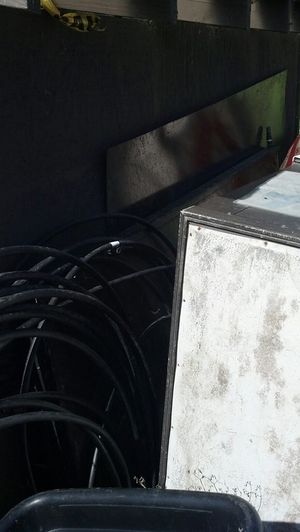
See Also[edit | edit source]
- Arcata Educational Farm
- Solar water heater - Basic principles and operations
- Parras, Mexico's solar water heater projects - Contains data logs and graphs from their testing phase
- Hotel Perote's solar pool heating project - One of the specific sites in Parras. Contains additional examples of the kind of mathematical/physical calculations that we'd probably want to incorporate.
